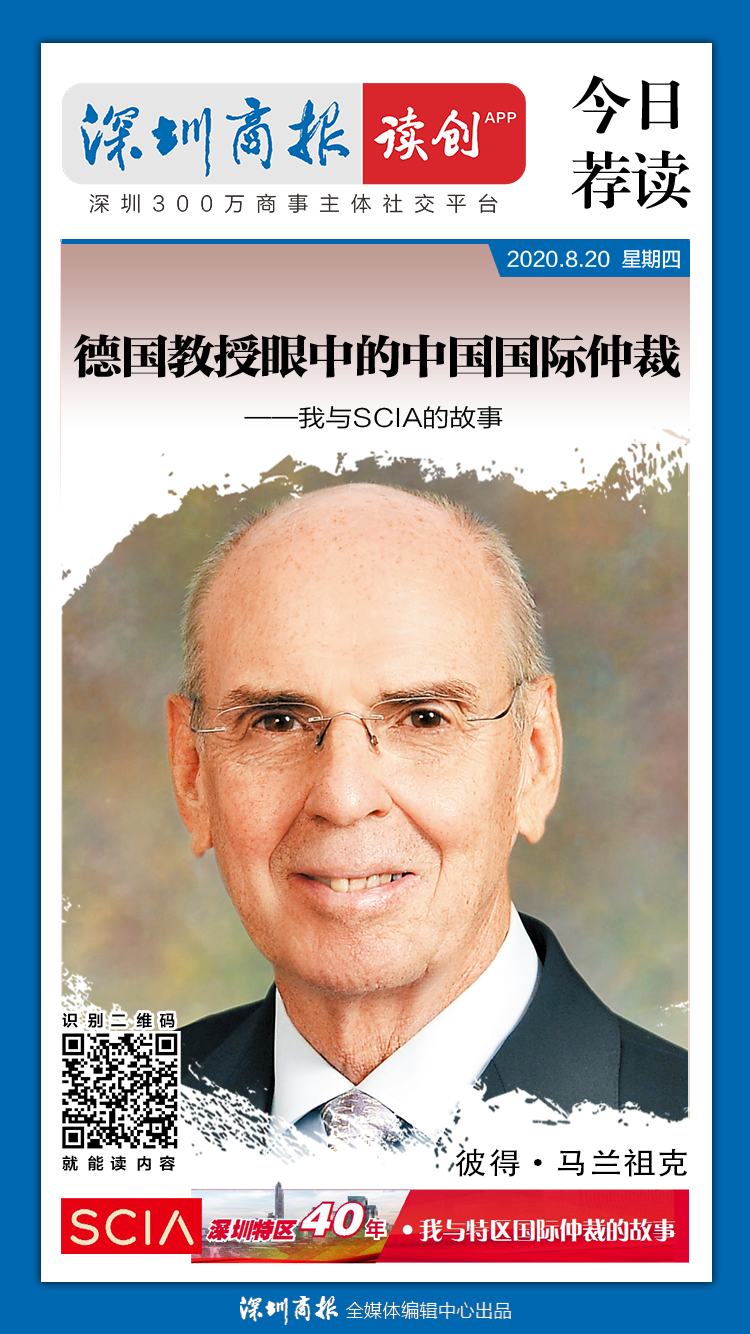
Some Remarks on International Arbitration in China: My Experience with the Shenzhen Court of Interna


Some Remarks on International Arbitration in China: My Experience with the Shenzhen Court of International Arbitration (SCIA)
Prof. Dr. Peter Malanczuk

The first time I heard about the arbitral institution in Shenzhen that was later called SCIA (Shenzhen Court of International Arbitration) was after 2001 when I had moved to Hong Kong from Europe and became Chair Professor and Dean of the School of Law at City University of Hong Kong. At City University, I also served as Director of the well-established MA Programme in Arbitration and Dispute Resolution. In the preparation of my courses I was surprised to learn that this arbitration body in South China was already established in 1983, only three years after the inauguration of the Shenzhen Special Economic Zone (“SEZ”), but still two years ahead of the Hong Kong International Arbitration Centre (HKIAC) which was formed in 1985 while Hong Kong was still under British rule. Moreover, it was interesting to note that the idea to set up the arbitration commission across the border in Shenzhen was promoted by Hong Kong business interests and arose from the emerging Guangdong-Hong Kong legal cooperation.
While being an independent arbitration commission, SCIA originally called itself "CIETAC South China" or "CIETAC Shenzhen". Basing itself in Shenzhen, the idea was to promote the oldest arbitration brand in China through a trilateral partnership with Beijing (i.e. the present CIETAC Beijing) and Shanghai (i.e. CIETAC Shanghai, the present SHIAC). But, as I was pleased to explain to my students, the CIETAC South China or Shenzhen (i.e. the former SCIA) also soon distinguished itself by being innovative in many respects and taking a lead in the development of arbitration in China. For example, it was the first arbitration institution on the Chinese mainland to include foreign professionals in its panel of arbitrators in 1984. It was also the first institution on the Chinese mainland of which an award was enforced under the 1958 New York Convention in 1989 (across the border in Hong Kong).
My real affiliation with SCIA, however, commenced in 2012/2013. In 2012, I was invited to join the SCIA Panel of Arbitrators as one of the foreign arbitrators on the list (in my case from Germany). Not long thereafter, in 2013, I was honoured with my appointment to the Council, the governing body of SCIA. I have been reappointed to the SCIA Council in 2017 for a term of five years until May 2022. Furthermore, in 2020 I joined the Board of Directors of South China International Arbitration Center (Hong Kong) (the “SCIA HK”), a new Hong Kong-registered affiliate of SCIA based at the International Finance Centre (IFC) in Hong Kong.
During the eight years I have so far spent working with SCIA, it has gone through important changes, including the famous so-called "CIETAC split" in 2012, when former CIETAC South China (i.e. the present SCIA) and former CIETAC Shanghai (i.e. the present SHIAC) jointly declared the termination of the trilateral partnership with CIETAC Beijing. The jurisdictional issues arising from the "CIETAC split" were finally settled by the Supreme People's Court in July 2015. The Court confirmed the legality and independence of SCIA in this decision. Another milestone was the merger of SCIA with the Shenzhen Arbitration Commission that was announced in December 2017. In the following brief comments, I would like to focus on two main aspects of my experience with SCIA, namely the SCIA Council and the SCIA Rules.
The SCIA Council
The innovative corporate governance structure of SCIA is focused upon the Council as the main governing body and, as such, it is unique in China. The council, supported by a structure of special committees, is responsible for taking all important decisions. It is independent from the government and designed to enhance openness and transparency.
The central and independent role of the Council is based upon special local legislation enacted by the Shenzhen Municipal Government in 2012 (Regulations on the Shenzhen Court of International Arbitration (for trial implementation), 24 November 2012) to ensure the independence, impartiality and integrity of SCIA arbitration. Art. 3 of the 2012 Regulations states:
“SCIA is a non-profit statutory body operating as an independent public institution. SCIA establishes a corporate governance system centered on the Council adopting effective mechanisms in decision-making, implementation and supervision.”
These Regulations are related to the Qianhai Project (the “Qianhai Shenzhen-Hong Kong Modern Service Industry Cooperation Zone”) the purpose of which is to engage Hong Kong, Shenzhen and Guangdong within the broader framework of the Pearl Delta Area (and now the “Greater Bay” blueprint) into close cooperation to develop a strong service-orientated economy for the Asia-Pacific and beyond. They also reflect the approval given by the PRC State Council of the General Plan concerning the Qianhai Project of 26 August 2010. The statutory seat of SCIA is in Qianhai.
According to Art. 6 of the above Regulations, at least one third of the council members must come from outside jurisdictions. As Hong Kong has its own legal common-law based legal system – although it remains an integral part of China under the “one country, two systems” principle, it qualifies as an outside jurisdiction in this regard. While the First SCIA Council (2012-2017) had 5 members out of 12 from outside jurisdictions, the Second SCIA Council (since 2017) includes 7 members out of 13 from outside jurisdictions.
The purpose of this internationalization of the Council is to strengthen its independence, to promote openness and transparency, and to integrate qualified outside advice into its decision-making process. For example, SCIA Council members from outside the Chinese mainland include Ms. Elsie Leung, the former Secretary for Justice of Hong Kong; Mr. Anthony Neoh, Senior Counsel in Hong Kong and former Chairman of the Hong Kong Securities and Futures Commission; Mr. Huen Wong, who is a former President of the Law Society of Hong Kong and a former Chairman of the Hong Kong International Arbitration Centre (HKIAC); and Mr. Rimsky Yuen, Senior Counsel in Hong Kong, former Secretary for Justice of Hong Kong, and the present Co-chair of the HKIAC.
It may be noted in this connection, that the internationalization of SCIA is further enhanced by the additional statutory requirement in the 2012 Regulations that
“at least one third of the panel arbitrators must be appointed from outside jurisdictions.”
In my experience, in practice the Council has operated independently and professionally. Council meetings have been competently presided over by Chairman Shen Sibao (and his predecessor Chairman Guo Xiaowen). They are well-prepared and documented in both Chinese and English by SCIA staff under the able guidance of SCIA President Liu Xiaochun. Both languages are also used in Council deliberations.
The SCIA Rules
Appointed as member of the SCIA Council’s Strategic Development and Rules Making Committee after joining the Council in 2013 and from 2017 onwards as Chairman of the Strategy and Rules Committee, I have always taken a special interest in the development of SCIA’s Arbitration Rules. The SCIA Arbitration Rules that had been adopted in 2012 were revised in 2016 and have been updated again most recently in 2019.
Under the relevant legislation and the Rules, SCIA’s jurisdiction is quite broad. It covers international cases, Hong Kong, Macao and Taiwan-related cases, as well as domestic cases. As the first arbitration body on the Chinese mainland, SCIA’s jurisdiction was extended in 2016 to further include investor-state disputes. Thus, SCIA may hear investor-state disputes and administer arbitrations under the UNCITRAL Arbitration Rules on the mainland. SCIA goes beyond investment arbitration and accepts the use of the UNCITRAL Arbitration Rules for international commercial disputes as well. The SCIA Guidelines for the Administration of Arbitration under the UNCITRAL Arbitration Rules (the “Guidelines”) constitute the first guidelines to apply UNCITRAL Arbitration Rules on the mainland.
SCIA arbitration rules attach great importance to the seat of arbitration as the latter is decisive for the governing procedural law and the nationality of the award. According to SCIA Arbitration Rules, in normal commercial arbitration cases, if there is no agreement of the parties, the seat of arbitration is the domicile of SCIA (Qianhai/Shenzhen), unless arbitral tribunal decides otherwise depending on the circumstances. In investor-state investment arbitration disputes accepted by the SCIA or commercial arbitration disputes applying UNCITRAL Arbitration Rules as agreed by parties, if the parties fail to agree on the seat and the tribunal does not decide otherwise, the default seat of arbitration is Hong Kong according to the innovative provision of the Guidelines. This implies that the courts of Hong Kong Special Administrative Region (the “Hong Kong SAR”) control the procedure and that the final award is considered an award made in Hong Kong SAR, enforceable under the relevant agreements applicable to the Hong Kong SAR, including the 1958 New York Convention and the relevant Agreement with the Chinese mainland.
The SCIA Rules put a strong emphasis on party autonomy. This complies with a clear mandate laid down in the local legislation mentioned earlier. Art. 17 of the 2012 Regulations stipulates:
“The foreign parties may agree on the application of SCIA arbitration rules or arbitration rules of other arbitration institutions at home and abroad, or the Arbitration Rules of the United Nations Commission on International Trade Law, and they may agree on a modification of SCIA arbitration rules as well as the applicable law, the formation of the tribunal, the conduct of the hearing, the rules of evidence, the language of arbitration and the place of hearing or arbitration, provided such agreement can be implemented and is not in conflict with a mandatory provision of the law as it applies to the arbitration proceedings.”
SCIA Rules further provide for efficient case dispute resolution mechanisms, backed up by a dedicated administrative structure of case management and allocation of staff and resources. Already the 2012 version of the Rules incorporated provisions on summary procedure, multiple contracts, joinder of additional parties, third parties, consolidation, and interim measures. The 2016 Rules, apart from adding investor-state dispute settlement, further included a duty of “bona fide cooperation” (Art. 6) and - at my suggestion - a new procedure for appointing emergency arbitrators (Art. 24). Among the innovations – again “a first on the Chinese mainland” - introduced by the latest 2019 revision of the SCIA Rules is an optional appellate arbitration procedure, supported by special guidelines.
Given the diverse nature of cases falling with the jurisdiction of the SCIA, in addition to the SCIA Arbitration Rules and the Guidelines on UNCITRAL arbitration and optional appellate arbitration procedures, the Council has further adopted special sets of rules for financial loans disputes; maritime and logistics arbitration; and online arbitration.
Arbitration as described above is a central pillar of the SCIA dispute resolution universe. But, building upon Chinese traditions, it forms part of a broader framework which has been described as “Diversified Harmonious Dispute Resolution”. This circle combines mediation and arbitration, on the one hand, and the facilitation of negotiation with arbitration, on the other hand. As regards mediation, it includes the Canton Fair Complaint Station for IPR and Trade Disputes,and the China Hi-Tech Fair Centre for Dispute Resolution Service, both established in 2007; the SCIA Mediation Centre, established in 2008; the Shenzhen Securities and Futures Dispute Resolution Centre, and the Guangdong, Hong Kong & Macao Arbitration & Mediation Alliance, formed in 2013. As far as negotiation is concerned, SCIA’s Negotiation Facilitation Centre assists parties in settling disputes through negotiations and offers the possibility of incorporating settlements into an enforceable arbitral award.
Conclusion
My experience in working with SCIA has been stimulating and positive. SCIA provides highly professional dispute resolution services with world class facilities located in the Shenzhen Stock Exchange Building.
SCIA’s internationalization policy (e.g. in the composition of the Council and the panels of arbitrators) has been successful and is further intensifying with more and more global contacts. It has gone hand in hand with Shenzhen’s internationalization policy, to which I was honoured to make a small contribution as a member of the Shenzhen Municipal Government’s Advisory Committee on the Internationalization of Shenzhen (2013-2018). SCIA has also demonstrated its openness to internationalization by kindly appointing me as a foreign Council member to lead (or co-lead) official SCIA delegations to Mauritius, South Africa, Spain, Singapore and Sri Lanka to discuss cooperation.
The modernization of SCIA’s Rules has been impressive, especially if one takes into consideration that the governing 1994 Arbitration Act in China is now a quarter of a century old and urgently needs some updating. Nevertheless, SCIA has made good efforts to follow international standards and it has often taken the lead in the development of arbitration in China. This is reflected in the increasing case load of SCIA which includes financial disputes, sale of goods disputes, real estate and construction disputes, corporate disputes, service contract disputes and investment and other disputes.
SCIA has greatly contributed to the rule of law through arbitration and mediation in the Pearl Delta. It will continue to play a decisive role in the context of building the Greater Bay Area and China’s Belt and Road Initiative. SCIA’s recognition by the China International Commercial Court of the Supreme People’s Court as its partner in South China (in the First Group of International Commercial Arbitration and Mediation Institutions in the "One-stop" Diversified International Commercial Dispute Resolution Mechanism) is but a well-deserved confirmation of this important role. All that leads me to conclude that both the domestic and international arbitration communities expect a bright future for SCIA.
Navigation
Arbitration Rules Model Arbitration Clauses Find an Arbitrator SCIA Guidelines Online Case Filing Online Office Fee Calculation X



